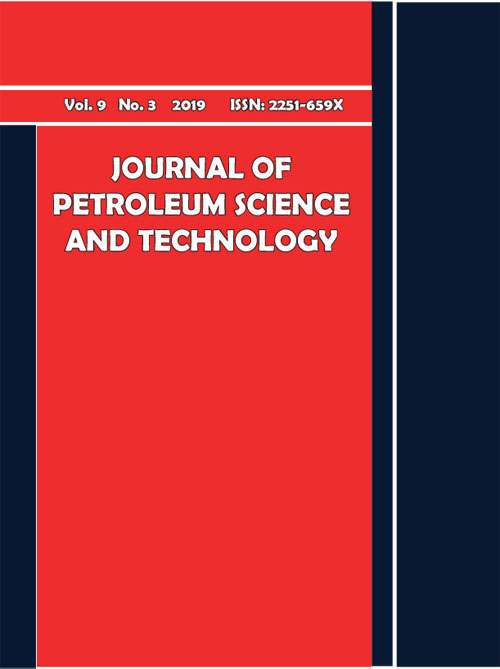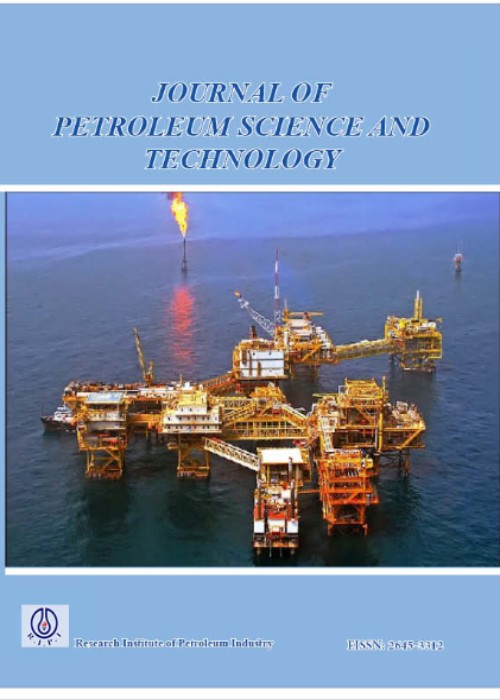فهرست مطالب

Journal of Petroleum Science and Technology
Volume:10 Issue: 1, Winter 2020
- تاریخ انتشار: 1398/10/11
- تعداد عناوین: 7
-
-
Pages 2-6Verifying the existence of a direct relationship between the inefficient use of natural gas and the high levels of CO2 contamination is indispensable. Therefore, in this study, the Data Envelopment Analysis (DEA) methodology to evaluate the efficiency in the use of natural gas from 11 pre-salt-producing fields was used. Both qualitative and quantitative data on the production of oil and natural gas, made available by the ANP, were analyzed. Afterwards, the Voador field was considered 100% efficient, while the least efficient fields were Búzios, Marlim, Sapinhoá, and Lula, respectively. This result confirmed the research hypothesis since Búzios, Sapinhoá, and Lula were expected to be among the least efficient fields, and they present the highest levels of CO2 contamination. However, Marlim’s great inefficiency highlights the fact that several other parameters greatly influence the best use of natural gas and should also be evaluated. Ultimately, the benchmarks identified in this study can help inefficient Decision Making Units (DMUs), as Marlim, in the search for techniques and production models that allow an improvement in the use of natural gas.Keywords: Natural gas, CO2, Pre-salt, SIAD, Data Envelopment Analysis
-
Pages 7-19The distillation towers of styrene monomer (SM) plants consume a considerable amount of expensive and toxic 2,4-dinitro-6-sec-butyl phenol (DNBP) as a polymerization retarder. The minimization of the operating cost, as well as preventing environmental pollution, is highly desirable to maximize the profit and have a clean technology. How ever, it is not easy to predict the actual usage of DNBP in the tower because of the nonlinear behavior of the industrial distillation tower in the polymerization process, and also the inaccuracy of experimental results of the DNBP in outlet products. To overcome these difficulties, a prediction model for determining DNBP consumption using a hybrid mod el in which the ANN in combination with Particle Swarm Optimization (PSO) is proposed in this study. Moreover, all useful parameters (9 parameters) in different years have been gathered from the industrial DCS system for training ANN. After combining PSO with ANN, the main valid parameters have been filtered. From nine proposed settings, five of them have been selected and used for predicting DNBP consumption in the SM plant. The obtained results showed that the proposed ANN-PSO hybrid model is a powerful tool for predicting DNBP usage with an average relative error of 9% between technical and calculated hybrid ANN-PSO model data.Keywords: DNBP, Artificial Neural Network, Particle Swarm Optimization, ANN-PSO hybrid
-
Pages 20-29
In case of a decrease in reservoir pressure, injection projects are inevitable that the desired production rate is maintained. Moreover, one of the key issues in injection operations is optimum injection pressure determination to prevent fault reactivation . The aim of this study is to evaluate fault reactivation tenacity in one of SW Iranian oil fields at different injection stages. Two main steps in this study are geomechanical modeling and fault extraction. In addition, fullset data, image log, dipole sonic log, and MDT pressure points were used to construct the geomechanical model. Also, 3-D seismic data were used for fault extraction and characterization. Ultimately, according to the geomechanical model, the stress state is strike-slip normal, and the maximum horizontal stress direction is toward NE-SW. Furthermore, 18 faults have been extracted using seismic data, which their strikes are often NW-SE. In addition, the faults are inactive in the present-day stress state, but the first fault will be reactivated with a 33 MPa increase in pore pressure.
Keywords: Fault Reactivation, Geomechanical modeling, Pore Pressure, Sarvak Formation -
Pages 30-36The shale formation drilling often generates a wide range of problems if ordinary water-based muds are employed. Furthermore, the alteration of shale formation has complicated the development of adequate drilling fluids. The con trol of shale instability by the exchange of potassium cations with shale structure is well accepted in the drilling fluid industry. In the cases where seawater or brackish water is used as a base, the presence of Na+ and Cl- in the drilling fluid can disrupt the shale cation exchange process. In this study, KCl fluids with concentrations of 1 to 15 wt% were prepared and analyzed with linear swelling, capillary suction time, and dispersion experiments on shale inhibition property, and then NaCl was added to potassium fluids at different concentrations. The different result of mixed salt fluid and KCl fluids indicated that the presence of sodium chloride could affect the potassium yield in the drilling fluid. Moreover, the low concentration of NaCl/KCl showed better results for shale inhibition, although the increase in NaCl concentration caused high swelling and decreased KCl efficiency in drilling fluid. Ultimately, it was found that the addition of 1 – 5wt% NaCl to 3 – 5wt% KCl was preferable to stabilizing old shale formation. But to drill active and young shale formation, the use of KCl alone in the liquid was recommended.Keywords: Drilling Fluid, KCl Fluid, Shale Swelling, Shale Inhibition
-
Pages 37-45
Underground gas storage is the primary means of managing fluctuations in supply and demand, and it is an essential component of an efficient and reliable interstate natural gas transmission and distribution network. Therefore, iden tifying gas storage capacity, injectivity, and containment is very important in every underground gas storage (UGS) project. Already, a giant scheme in Iran for identifying, ranking, and certifying UGS reservoirs has been carried out through the country. In this study, a methodology for a fast screening and risk ranking of candidate reservoirs, which in principle does not discard the green and slightly small reservoirs with few wells, is demonstrated. First, four structures out of more than twenty given structures were selected according to the client’s comments. Then, the performance of these candidate structures as the main focus of this study was determined. For performance analysis, the flow simulation method that can be characterized by the uncertainty conditions influencing deliverability behavior was applied. Based on the available data, the main uncertainty parameters (static, dynamic, and economic) affecting capacity, injectivity, and containment were determined. Then, based on designing many wells as a producer and as injectors, the distribution probability of deliverability of structure under different uncertainty was identified. Finally, the performance and the risk of each candidate structure were analyzed and compared, and then they could be ranked and proposed for further detailed implementation.
Keywords: Underground Gas Storage, Ranking, Flow Simulation, Uncertainty -
Pages 46-53Providing information about the role of the major elements controlling the type of Pliocene deposits in the south eastern part of the Caspian Basin by assessing regional and global parameters is very important to demonstrate the relationship between the tectono-sedimentary evolution and facies distribution of the area, and thereby discover the fields with the best stratigraphic and structural traps potential. Also, there is an indispensable query: which factors had controlled the the Type of Pliocene Deposits in the Southeastern Caspian Basin, NE Iran? In the present research, the Cheleken and Akchagyl formations with the Pliocene age, as the most potent constituents of reservoir intervals in the Caspian Basin, were investigated by considering facies types and the factors that controlled their variations. This research was done based on field observations, microscopy studies, and 2D seismic interpretations. Interpretation of facies and correlation along three surface stratigraphic sections and eleven exploration wells clearly justify the role of tectono-sedimentary agents controlling the distribution of the Pliocene formations in the Gorgan and Gonbad plains. Furthermore, the thickness of the Cheleken Formation increases towards the South Caspian Basin (SCB), and lithologically, it is mainly composed of conglomerates and gravely sandstones at the marginal parts grading into the silty claystone to marl facies towards the SCB. In addition, deposition of the Cheleken was accompanied by sea-level falling, and rapid subsidence resulted from the uplift and subsequent erosion of the Alborz and Kopet Dagh moun tains. In contrast, the Akchagyl Formation represents a relatively uniform thickness, and lithologically, it is consists of high-energy carbonate facies in the northeastern Gonbad-e Kavous area changing into the claystone and siltstone facies towards eastern parts of the South Caspian Basin. Ultimately, according to this study, it is found out that Akch agyl Formation records a major regional transgression and reconnection of the study area to the global oceans, which was confirmed by the presence of marine biota and flat geometry pattern of the sedimentary basin.Keywords: facies, Pliocene Deposits, Southeastern Caspian Basin, NE Iran
-
Pages 54-63Oil production enhancement has been a major area of study in recent decades. This term includes several types of technics. One of the production enhancement technics is using electrical submersible pumps (ESPs) to increase the rate of production from oil wells. In the present study, the economic value of using ESP pumps has been evaluated by implementing them on the wells of a large integrated model of a south western Iranian reservoir, which involves reser voir, wells, and surface facilities models. Besides, sequential quadratic programming was used to evaluate its efficacy in optimizing the production scenario. Therefore, four production scenarios were compared regarding their net present value and cumulative oil production in 20 years of production. The scenarios were (1) non-optimized natural flow, (2) optimized natural flow, (3) non-optimized ESP-implemented, and (4) optimized ESP-implemented. Ultimately, the re sults showed two points: First, Electrical Submersible Pumps (ESP) are a good choice for the production enhancement of the field of this study and leads to increased net present value. Second, the sequential quadratic programming is a rigorous algorithm, which can be employed to increase production revenue of a field with several decision variables and constraints.Keywords: Integrated modeling, Production enhancement, Artificial Lift, Electrical Submersible Pumps, Sequential quadratic programming, Net Present Value


